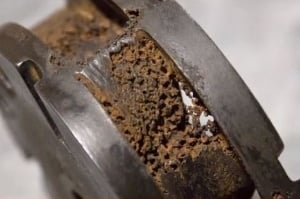What is pump cavitation?
Simply defined, cavitation is the formation of bubbles or cavities in
liquid, developed in areas of relatively low pressure around an
impeller. The imploding or collapsing of these bubbles trigger intense
shockwaves inside the pump, causing significant damage to the impeller
and/or the pump housing.
If left untreated, pump cavitation can cause:
- Failure of pump housing
- Destruction of impeller
- Excessive vibration - leading to premature seal and bearing failure
- Higher than necessary power consumption
- Decreased flow and/or pressure
There are two types of pump cavitation: suction and discharge.Suction Cavitation
When a pump is under low pressure or high vacuum conditions, suction cavitation occurs. The pump is being "starved" or is not receiving enough flow. When this happens, bubbles or cavities will form at the eye of the impeller. As the bubbles carry over to the discharge side of the pump, the fluid conditions change, compressing the bubble into liquid and causing it to implode against the face of the impeller.An impeller that has fallen victim to suction cavitation will have large chunks or very small bits of material missing, causing it to look like a sponge.
Possible causes of suction cavitation:
- Clogged filters or strainers
- Blockage in the pipe
- Pump is running too far right on the pump curve
- Poor piping design
- Poor suction conditions (NPSH requirements)
Discharge Cavitation
 When a pump's discharge pressure is extremely high, or runs at less
than 10% of its best efficiency point (BEP), discharge cavitation
occurs. The high discharge pressure makes it difficult for the fluid to
flow out of the pump, so it circulates inside the pump. Liquid flows
between the impeller and the housing at very high velocity, causing a
vacuum at the housing wall and the formation of bubbles.
When a pump's discharge pressure is extremely high, or runs at less
than 10% of its best efficiency point (BEP), discharge cavitation
occurs. The high discharge pressure makes it difficult for the fluid to
flow out of the pump, so it circulates inside the pump. Liquid flows
between the impeller and the housing at very high velocity, causing a
vacuum at the housing wall and the formation of bubbles.As with suction cavitation, the implosion of those bubbles trigger intense shockwaves, causing premature wear of the impeller tips and pump housing. In extreme, discharge cavitation can cause the impeller shaft to break.
Possible causes of discharge cavitation:
- Blockage in the pipe on discharge side
- Clogged filters or strainers
- Running too far left on the pump curve
- Poor piping design
Cavitation Prevention
If your pumps are experiencing cavitation, check these things to troubleshoot the problem on your own:- Check filters and strainers - clogs on the suction, or discharge side can cause an imbalance of pressure inside the pump
- Reference the pump's curve - Use a pressure gauge and/or a flowmeter to understand where your pump is operating on the curve. Make sure it is running at its best efficiency point
- Re-evaluate pipe design - Ensure the path the liquid takes to get to and from your pump is ideal for the pump's operating conditions
Cavitation is a common problem in pumping systems, but with proper pump sizing, pipe design, and care of filters and strainers, damage to pumps and their impellers can be largely avoided.

EmoticonEmoticon